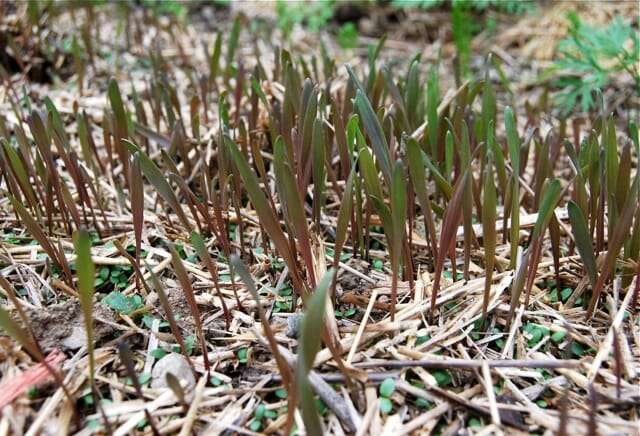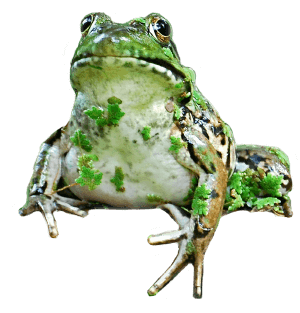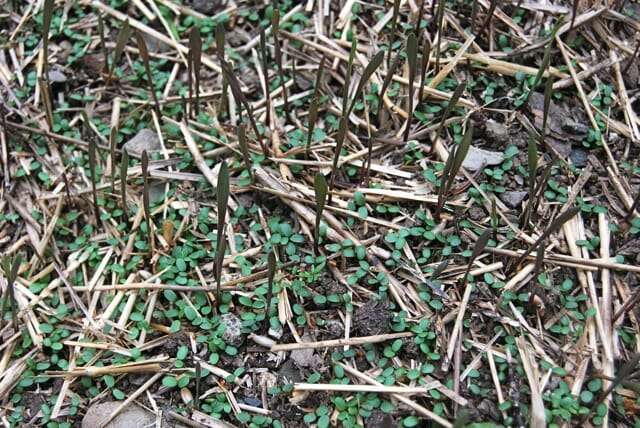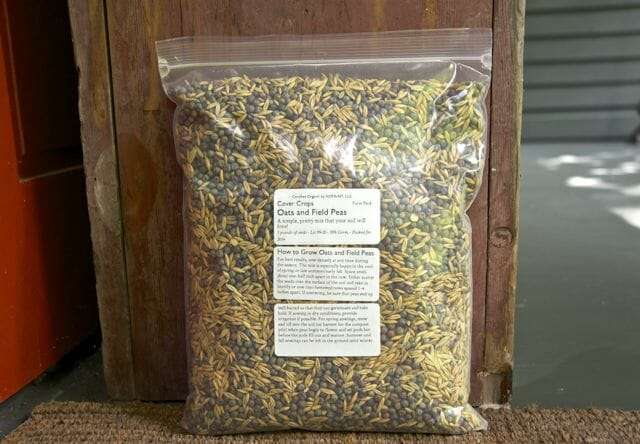cover crops: feeding the soil that feeds me
 A MONTH OR SO BEFORE KILLING FROST, the vegetable-garden soil that fed me gets a meal, or at least the promise of one. I sow soil-sustaining cover crops (always from non-GMO, organic seed) as my various food crops are harvested, gradually turning raised vegetable beds into mini-fields of winter cereal rye (above) and mammoth red clover for the colder months, or maybe a mix of quick-to-grow, easy-to-manage and beautiful field peas and oats.
A MONTH OR SO BEFORE KILLING FROST, the vegetable-garden soil that fed me gets a meal, or at least the promise of one. I sow soil-sustaining cover crops (always from non-GMO, organic seed) as my various food crops are harvested, gradually turning raised vegetable beds into mini-fields of winter cereal rye (above) and mammoth red clover for the colder months, or maybe a mix of quick-to-grow, easy-to-manage and beautiful field peas and oats.
Come spring, several weeks before I plan to plant each area, I’ll cut or mow or pull the grain and legume combination down, depending on which pair I used and where they’re located, then turn under the remains. It’s like composting in place, with the foliage and underlying root system decomposing to improve soil texture and fertility.
Cover crops can serve other purposes: Some specialized ones, like various Brassicas, can also provide not just biomass but other benefits including pest and disease control (more on that from Cornell). The subject is much wider than this simple explanation, but stated most simply:
- Grasses (like rye, sorghum-sudangrass crosses, and wheat) add organic matter to the soil very effectively. Note that I don’t list buckwheat here, another great, fast-growing cover crop that bees love, too. That rhubarb and sorrel relative is not technically a grass or grain, though we think of it as such because of how we use it food-wise.
- Legumes (clovers, cow and field peas, vetch) with their inherent Nitrogen-fixing capability, provide Nitrogen effectively. Plus: you can even eat the leafy tips and blooms and young pods of field peas along the way, if you choose that one.
- Brassicas and Mustards (rapeseed or canola; radish; mustard) have proven effective against various nematodes, fungi and insects.
Cover crops—there are varieties for each season and each climate—also serve as a living mulch, protecting the soil from erosion. They thwart other weeds, making the management of fallow garden areas (such as during crop rotations) easier than just standing back and watching undesirable plants take over.
Even well into September, it’s not too late to plant winter rye here in my cold zone, as it will germinate as low as in the 30s, but I prefer to give it about four frost-free weeks if I can, so I just start as the beds come empty. I find that if I wait until the garden’s a blank slate it never happens, so it’s easier to just rake empty areas gently and then broadcast seed, covering it according to the individual crop’s directions.
Keeping a bag of organic seed or a mix of each of your chosen cover crops on hand insures you’re always ready (that’s winter rye blades and the just-germinated red clover, above).
If I had empty areas in spring I might use hairy vetch or oats or field peas here, or a convenient pre-packed mixture; in summer, I could use annual ryegrass or buckwheat, among others. Depending where you live, and what your purpose and timing is, here are some sources of high-quality seed, and a list of resources for more information below that:
- Hudson Valley Seed Library has organic, garden-sized single-ingredient or blended packages (like the one above). I was able to cover 1,000 feet, for instance, with oats and field peas.
- Johnny’s Selected Seed in Maine offers many varieties, including some organic, with a helpful chart for cross-comparison.
- Peaceful Valley, in California, has a selection for various regions, and a how-to video on cover crops.
- Bountiful Gardens, in California calls them “compost crops.”
- Cornell University has a tool for deciding which cover crop to use in your vegetable garden, plus articles on fall cover crops.
more information on cover crops
SOME OF THESE resources are geared to farmers, but have useful information on timing and how-to-grow tactics nonetheless.







Gaia’s Garden: a guide to homescale permaculture is a great book and has some great charts about all the different kinds of green manures and what they add to the soil and what kinds of soil they’re good for.
Love using green manures — helps smother out the weeds as well. I regularly use the grasses and legumes, but didn’t know about the brassicas! will have to try. Thanks!
I want to try a cover crop this fall, but I am not sure if I am too late. I live in MN (zone 4). I ordered a compost mix that contains fava, vetch, wheat and rye. Will this work for my area? Also, the fava beans are separate, and I am unclear if I should plant them now or in the spring.
Welcome, AmyD. The University of MN Extension Service has a bulletin on cover crops for your area; favas can be for winter, yes, but I think in extra-cold areas they are sown late summer to get a jump. Have a read. I might be tempted to save them for early spring instead. The vetch and (winter) wheat and rye are perfect; get them in now.
Margaret, do you know if fava beans are among those recommended as cover crops? Seems like I heard that once. Ever tried growing them?
Ooops…I clicked on one of the seed sites and they’re listed right there, plain as day. Anyway…ever tried growing them? I think my Lebanese father might just cry if I showed up for Christmas with fresh fava beans.
When you say you turn them under in spring, do you mean with a roto tiller or can you just do it with a spade or fork?
Welcome, Maggie. Either way; mine are in raised beds, so I use a shovel or fork or both, since the tiller cannot get in there. You will have to kind of chop a bit like you would any clods of old growth you were turning under. Let it decay a bit, then turn again. Hope to see you again.
Thanks for your help! I will get them in the ground today.
It is my understanding that rapeseed (canola) is genetically modified. That is why I don’t buy canola oil. Don’t think I’ll be using that in my garden or in my body. Check your chips and peanut butter too. Like soybeans and Montsano these genetically modified crops are spreading worldwide.
Planting legumes seems like the easiest thing for me (next year, obviously). Do you just plant them right before the first frost and leave ’em be? I’m in a snowy climate. Will they be OK over the winter?
I live in Southwest Florida….any seed for my area?
Hi, Maryjane. This info from your state extension is for vegetable farming, but the same crops would apply I expect on a much smaller scale. I would look into the aftercare of each one (e.g, how easy or hard to turn it under). Then you can order seed from one of the sources listed in my article if you know what ones you are seeking.
I planted a mixture of oats, buckwheat, radish, and peas yesterday, trying this cover crop business for the first time. Some was in new raised beds, and some were in little patchy areas that are coming clear as various crops are finishing up. The buckwheat won’t get very far in the next 6 weeks (we’re in central Massachusetts) but should produce some mulch for next year. Thanks for the tip about the rye. We’ll add that later, as the frost kills off the sensitive plants. and leaves bare areas.
Hi, Sonia; about to plant more here today, too. Nice to “see” you here.
Hi Margaret,
I’m in your zone ( Ghent) and just getting to this now. Im guessing if I ordered now it might get here in a week or week and a half. Too late? Which kind would you suggest?
Thanks
Amy
What a timely post for the onset of fall Margaret! Another plant to mix in with cover crops that came to my attention is daikon radish. Seems strange as I buy daikon at my farmer’s mkt. But it’s true. My other half was visiting farms in Ohio and one of the farmers uses daikon because it “drills” down into the soil and creates space for water and air to infiltrate the soil, and later, as the radish rots, it is food for beneficial soil invertebrates and microbes.
This farmer, near Columbus, OH, has been using cover crops and no-till methods for 40 yrs and the quality of his soil is off the charts in terms of organic matter content. He never, repeat, never waters the crops in his cover-cropped, no-till fields. The winter temps kill off most of the cover crop. He leaves the dead plants in place (mostly mulch by the following spring) and plants seeds through this mulch layer. If anyone wants to see his daikon cover crop go here.
Thanks, Anne. Radishes are good cover crops, you’re right. Thanks for adding to the conversation!
here in Maine the garden is still producing. I have tried cover crops before and had a heck of a time turning them in spring. too much growth. had to dig the cover crop out. wasting my time and the soil on the cover crop roots which went into the compost heap. so I skip the cover crop these days.
Margaret,
Very timely article. I was just thinking of trying cover crops in my raised beds. I have not used them since switching from a tilled garden to raised beds. I always used rye in the past and bought it from the local farm seed business. They most likely are GMO these days.
I grow 1\2of the garden, and leave the other half to rest. Planted buckwheat in the resting part and cut it down and spread it out. Thinking of planting winter cover crop until I use it in the spring, and possibly the same crop in the just used half that I planted. What would you suggest for a cover crop for winter?
Upstate new York.
Hi, George. I have done the red clover/winter rye in the past, and this last week or so I just sowed field peas/oats, which comes up really fast and gets thick fast…so I am encouraged by that combo, too.